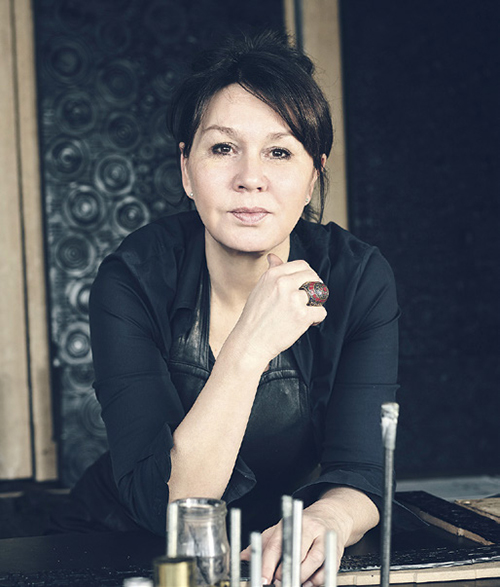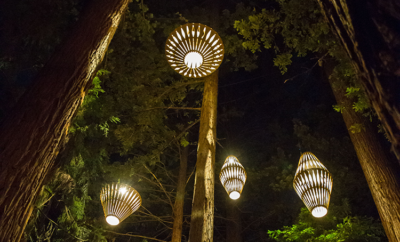 COURTESY CARPENTERS WORKSHOP GALLERY
COURTESY CARPENTERS WORKSHOP GALLERY
Design
The New Bronze Age
THE FURNITURE OF FRENCH-SWEDISH ARTIST INGRID DONAT calls for both ample space and close inspection. The surfaces of her chairs, commodes, tables, and other works are inscribed with a vast yet detailed ecosystem of shapes and textures. Circles, arcs, lines, slits, and punctures—like those found on an abstract tapestry—metamorphose into delicate constellations. Take a few steps back, though, and her pieces, with their streamlined yet sinewy forms, are anything but ethereal and have a commanding presence in a room. Often rendered in her trademark bronze—a material she has tested, plied, etched, molded, and transformed again and again—they exude an unwavering confidence. In many ways, the works are a perfect union of her early education in drawing at the Delarue Studio and her later interest in larger three-dimensional forms.
For nearly twenty years, Donat’s meticulously crafted sculptures and pieces of furniture have been exhibited at galleries and art fairs in Paris, London, New York, Miami, and elsewhere. She is represented by Carpenters Workshop, the gallery cofounded and run by her son Julien Lombrail, and she is currently participating in a residency at Carpenters Workshop | Roissy, a new large-scale research and development space, which brings together artisans of every stripe to work with designers and artists.
The past year has been particularly creatively fertile for Donat, who unveiled six new sculptural pieces in the exhibition Origins, at Carpenters’ London gallery in May. Informed by tribal motifs and art deco design, the works also paid homage to her connection to the lush landscape of the island of La Réunion, known for its volcanic rock. Next up, an exhibition at Carpenters Workshop’s New York location, in the former Takashimaya building, that will coincide with the publication of the first monograph of Donat’s work, issued by imprint Éditions Norma and written by decorative arts specialist Anne Bony, with a foreword by Donat’s friend, renowned architect Peter Marino.
As witnessed by her sculptures, Donat is a master of intriguing contrasts, weaving together seemingly disparate concepts: the masculine with the feminine, the delicate with the muscular, and the influences of European design traditions with African artistry. We recently had the chance to catch up with Donat to discuss her new monograph and upcoming exhibition, and the ongoing evolution of her sculptural works and creative process.
NICOLE ANDERSON/MODERN MAGAZINE: Tell me a bit about your background and your trajectory to becoming an artist. What drew you to the arts?
INGRID DONAT: My life has always been influenced and surrounded by art. When I was five, my mother left Paris with my brother and me, and returned to Sweden. We lived in Falun in the Dalarna region, which is where I spent my childhood. My grandfather was an architect, and although I never met him, he influenced me a great deal. In Sweden we spent a lot of time with my grandmother in the art deco style house my grandfather built in the 1920s. To this day, the details of the space remain ingrained in my memory.
I didn’t excel at school, which concerned my mother. I was much more of a dreamer and enjoyed the freedom that came with creative expression. At seventeen, she sent me to my father for a gap year in Paris. He encouraged my creativity, and together we shared a love of painting. I enrolled in the Delarue Studio, which prepared students for the competitive entrance exams for Paris’s École des Beaux Arts. I soon met my now ex-husband, Francis Lombrail, who was an auctioneer and expert in modern paintings, art nouveau, and art deco. Art was an integral part of our lives, in conversation, in our home in Villennes-sur-Seine, and in our social circle of friends, which included the artist César, Diego Giacometti, and Sylva Bernt—André Arbus’s partner.
It was at home working in the garden while pregnant with our second child that I began working with clay. I had an immediate affinity for the medium. My first work depicted a pregnant woman. Francis saw potential and encouraged me at this early stage, when I didn’t yet envision myself as an artist. I was fortunate enough to have the exceptional Sylva Bernt as a mentor, who trained me in different techniques. At the time, I wasn’t selling work, but rather making it for my own pleasure and for those around me.
Simultaneously, the art nouveau and art deco furniture exhibitions organized by Francis piqued my interest in design. I loved the refinement, craftsmanship, luxurious materials, and subtle details of art deco. I spent a lot of time in the studio of Diego Giacometti, whom I liked enormously. One day after I purchased a console table from him he said to me, “Make your own furniture yourself!”
MM: How did your start in drawing at the Delarue Studio inform or lead you to sculpture and furniture? Is there a thread between what you created with pen and paper and the three-dimensional works you do today?
ID: When I entered the Delarue Studio, drawing was my primary form of expression. The training was quite academic, with careful attention to the human form and life drawing, which trained me to understand the complexity of the human body—its form, silhouette, and mass. I enjoyed the speed of sketching and savored its freedom and its unlimited movements. This emphasis on the human figure, developed through sketching, has continued to influence my sculpture and functional pieces. The act of drawing and the hand can also be seen in the intricate graphic motifs on the surface of many of my works.
MM: What led you to create functional pieces versus pure sculpture?
ID: Diego’s charge to make my own furniture really had an impact on me. I was already quite interested in furniture and interiors, stemming from my childhood in the art deco house in Sweden and the influence of my ex-husband’s work and our sphere of artist friends. I think maybe my practical Swedish side likes the idea of purpose and utility in an art object. In terms of technique, a decisive shift to functional sculpture happened in 1997, when I started to conceive architectural structures, such as a base or cage, to delineate space for my figures. The next year, I had an exhibition in Paris showing these sculptures along with the furniture I had made for my home. The success of the show surprised me and solidified my direction. As I honed my skills and had a better idea of what materials worked best, my unfailing fascination with the female body inspired the use of caryatids in functional pieces. I created sculpted uprights of women with lowered heads for a series of pieces that included a daybed, banquette, benches, chairs, and tables. My Caryatide series was the first body of work I realized with the intent of creating functional sculpture.
MM: What is it about primitive and tribal arts that interests you? And how do art deco and art nouveau influence your designs?
ID: Tribal arts have served as an inspiration for many artists, like Picasso and Brancusi. For me, I like the idea that tribal art has an instinctive quality, like folk art, and is independent of the formal academics of Western art. I am drawn to the African tradition of scarification—creating marks upon skin—and the intricate repetition of a graphic motif, which translates well to bronze. Much of what I know about art nouveau and art deco is from my ex-husband, who organized furniture exhibitions. The exceptional craftsmanship and luxurious materials of these styles are a constant source of inspiration and have informed my current way of working with highly specialized artisans. In particular, I’m drawn to the refined details and sophistication of art deco. Designers like Pierre Legrain and Armand-Albert Rateau were also drawn to tribal art, so you see, these sources of inspiration are closely connected.
MM: Could you tell me about your artistic process— how you conceive a work from its inception to its completion? Does it begin with a fully realized idea or plan or does it evolve over time?
ID: I never know what kind of furniture I will make when I start a piece. I work on wax panels first, engraving and sculpting—it’s gestural and akin to drawing. Then when the motif emerges, I think about what kind of furniture it would suit. I let the material and the patterns dictate the process. I think above all I love the birthing of a creative concept, whether it is with clay, wax, or bronze. When I come in contact with raw material, it triggers the act of creation, without me necessarily having an endpoint in mind. The work is constantly in the process of becoming. To me, a work is never finished.
MM: Bronze features so prominently in your work. What about this material calls to you?
ID: To me, material is very important and I have experimented with a very wide array, including leather and parchment. The form of a given material—its strengths and limitations—often inspires the ultimate form of a piece. For me, 2005 was a significant year of change. I stripped away the unessential and moved toward abstraction. It was during this time that I dedicated myself to bronze, which has become a signature material for me. I find that bronze is cold at first. I try to warm it up by etching and sculpting the surface, like a tattoo or the skin of an animal. The material allows me to create the delicate, intricate details I want to achieve. I like to challenge its limits.
MM: There’s an interesting balance of masculinity and femininity in your pieces. What inspired this contrast?
ID: I think the contrast and balance of masculine and feminine is a result of my ongoing sources of inspiration—tribal art and art deco—and the formal characteristics of bronze.
The cold, heavy solidness of bronze is masculine, which contrasts with the feminine refinement, restraint, and sensuality of art deco. For example, when a repetitive, delicate lacework motif is applied to bronze, a lightness is created, evoking the feminine in a masculine material.
MM: You have a residency at Carpenters Workshop | Roissy. What has that experience been like and has it enabled you to explore new ideas or processes?
ID: Roissy is a very special space. Organized in the French tradition of the Arts Décoratifs, it brings together the best artisans: prototypists, parchmentfitters, chiselers, patina specialists, engravers, gilders, coppersmiths, and blacksmiths. In this way it is a site for innovation alongside the preservation and transmission of traditional techniques. Working at Roissy has allowed me to follow every step of production intimately. At my disposal are a wax workshop, tapestry workshop, patina parchment workshop, wood finishing workshops, a metal workshop, and a casting workshop. The wealth of resources is tremendous and has enabled me to experiment with different materials and make more technically sophisticated work. Anything is possible and we can test ideas quickly.
MM: How has your work evolved and changed over the years?
ID: In 2005 I made a conscious shift toward abstraction in my work. It became less figurative and more minimalistic. I approached the surface of furniture like a painter to a canvas to which I would transfer my rhythmic language of signs—circles, lines, rings, staples, squares, and notches. In order to achieve the exact effects I want in an engraved motif, I have developed my own tools. These tools and my technical approach continue to evolve. Still, the intricacy of my engravings and my exacting demands on the technical approach to a piece remain the same. There is a sensual and spiritual quality in all of my work that gives it a timelessness. I am not interested in trends.

Artist Ingrid Donat in her studio. | ARNO LAM PHOTO












